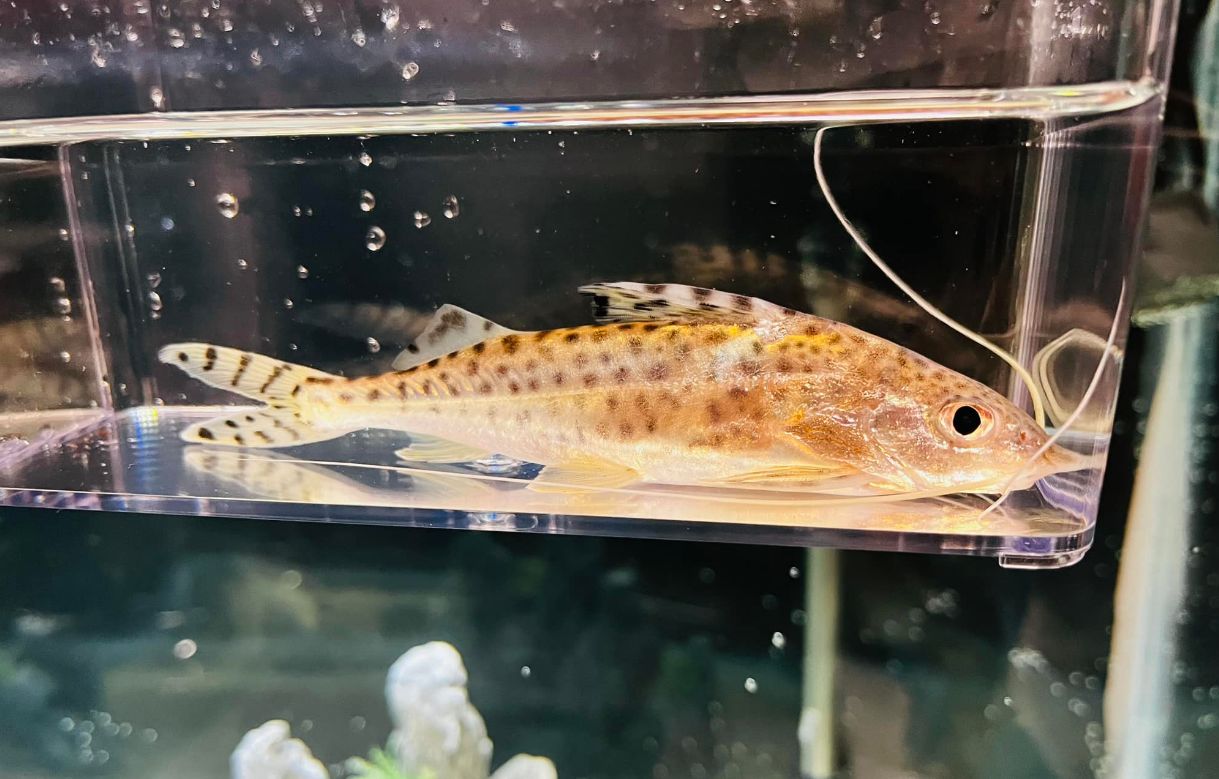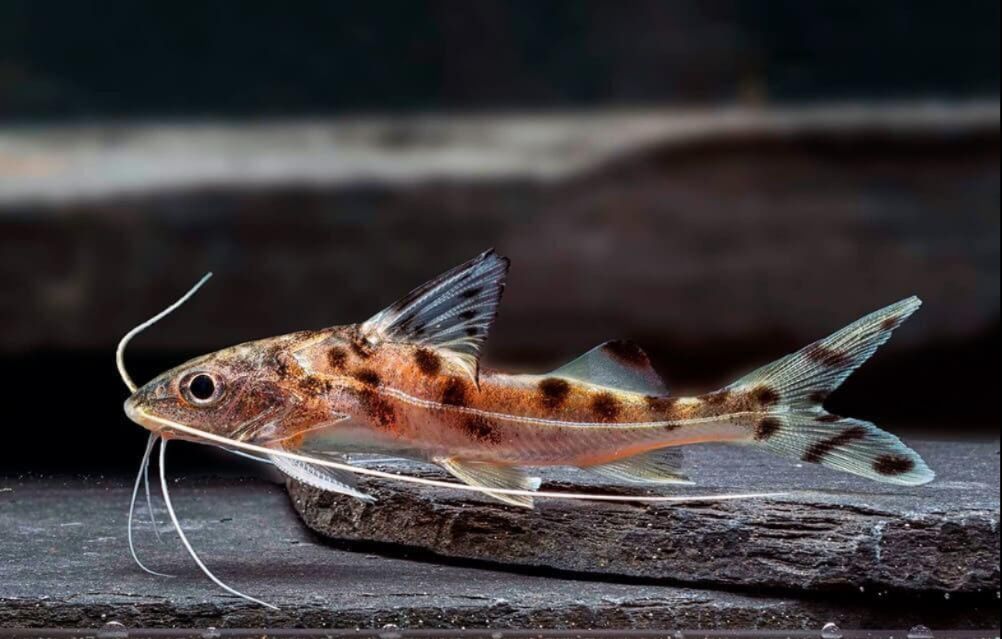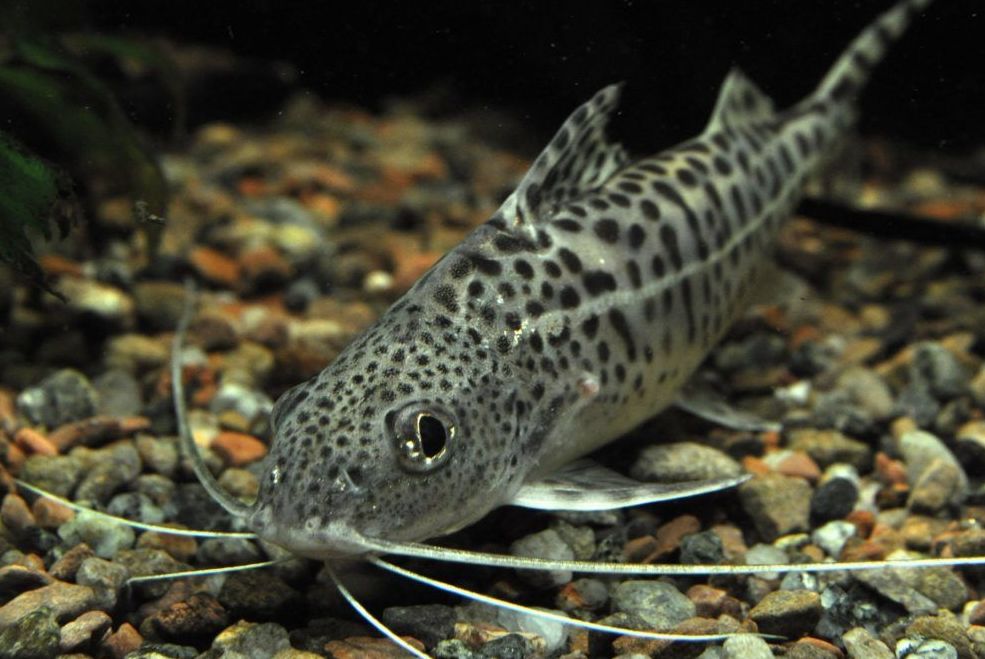Pictus catfish, commonly appreciated among aquarium enthusiasts, are medium-sized fish belonging to the catfish family. Known for their striking spotted patterns and playful demeanor, these fish can be a delightful addition to your tank. This article will guide you through the essential aspects of keeping pictus catfish, including proper care, feeding habits, suitable tank mates, and breeding tips.

Contents
Habitat in the wild
The pictus catfish is a captivating member of the long-whiskered catfish family, Pimelodidae, which comprises a diverse group of freshwater catfish primarily found in South America. These catfish are known for their long, sensitive barbels, which function like whiskers, helping them locate food in murky waters. While the family includes species that can grow several feet in length, the pictus catfish remains relatively small, making it a popular choice for aquarists.
Originating from the Amazon and Orinoco river systems in Peru and Colombia, pictus catfish inhabit slow-moving waters with sandy or muddy bottoms. They thrive in densely vegetated areas, often seeking cover among submerged tree roots, fallen branches, and aquatic plants. This schooling fish is typically found in large groups, enhancing its social dynamics and providing security.
The natural habitat of pictus catfish features warm, tropical waters with temperatures ranging from 72°F to 78°F (22°C to 26°C). The water is generally slightly acidic to neutral, with a pH between 6.5 and 7.5, and tends to be soft to moderately hard. The riverbeds are often composed of sandy or fine-gravel substrates, perfect for these bottom-dwelling fish.
As a benthopelagic species, the pictus catfish becomes most active during dusk, when it hunts for food. Its diet consists of small fish, snails, prawns, larvae, fruits, insects, and detritus. Using its sensitive barbels, it skillfully navigates its environment to find prey, showcasing its adaptability in the wild.
Pictus catfish are often confused with upside-down catfish, which belong to the Synodontis genus found primarily in Africa. While both types are catfish and share some physical characteristics, they differ significantly in behavior and habitat. The pictus catfish swims upright and is known for its energetic movements, whereas upside-down catfish are unique for their habit of swimming upside down. Understanding these distinctions helps aquarists make informed choices when selecting fish for their tanks.
Additionally, pictus catfish communicate using low-frequency sounds, a trait shared by many catfish species. These sounds facilitate interaction in their often murky habitats, allowing them to signal each other and maintain social cohesion within their schools. This behavior highlights their social nature and adaptability, making them even more fascinating to observe in an aquarium setting.

Description
Size
In a tank pictus catfish can grow up to 16 centimeters (6.3 in) long, but as a rule it is 11.0 centimeters (4.3 in) long. However, some individuals may reach slightly larger sizes, but they typically stay within this size range in captivity.
Lifespan
The lifespan of pictus catfish can vary based on environmental conditions, care, and genetics. Generally, these catfish have a moderate lifespan compared to many other fish species. With proper care in an aquarium setting, pictus catfish typically live for about 5 to 8 years. However, some well-maintained individuals have been known to live up to 10 years or more, although this is less common.
Body
The pictus catfish is characterized by its tall, elongated body and a distinctive triangular dorsal fin. This fish features three pairs of short barbels, with one pair on its upper lip being notably longer. These sensitive barbels are crucial for locating food in murky waters, enhancing the fish’s ability to forage effectively.
The tail fin of the pictus catfish is bilobular with a deep cut-out, contributing to its agile swimming style. Its main body color is a silvery hue, adorned with round black spots that also appear on the fins, creating a striking appearance that adds visual interest to any aquarium.
When transferring a pictus catfish from one tank to another, it’s essential to use a dip net. The fish has sharp spines on the first rays of its pectoral fins that can cause painful injuries, so handling with care is crucial to ensure the safety of both the fish and the aquarist.
| Characteristic | Description |
|---|---|
| Scientific Name | Pimelodus pictus |
| Common Name | Pictus Catfish |
| Family | Pimelodidae |
| Origin | Amazon River basin, South America |
| Size | 4 to 5 inches (10 to 13 centimeters) |
| Color | Silver or light gray with numerous small black spots |
| Body Shape | Slender and elongated |
| Barbels | Long, flowing barbels around the mouth |
| Behavior | Nocturnal, peaceful, and sociable |
| Diet | Omnivorous, feeds on small insects, crustaceans, plants |
| Aquarium Size | Medium-sized aquarium |
| Tank Requirements | Plenty of hiding spots, caves, driftwood, and plants |
| Substrate | Sandy or fine-gravel substrate |
| Water Parameters | Temperature: 72°F to 78°F (22°C to 26°C) |
| pH: 6.5 to 7.5 | |
| Water hardness: Soft to moderately hard | |
| Breeding Difficulty | Challenging, requires specific conditions |
Difficulties in keeping
Pictus catfish are relatively simple to care for in an aquarium, making them suitable for both beginners and experienced aquarists. However, it’s important to note that these catfish are primarily active in the evening and at night, mirroring their natural behavior in the wild. During these hours, they exhibit their hunting instincts, which can include preying on smaller fish.
When setting up a tank for pictus catfish, it’s beneficial to consider their nocturnal nature. Providing dim lighting or areas of shade can encourage their natural behaviors and make the aquarium environment more comfortable. Additionally, being mindful of tank mates is crucial, as their predatory tendencies may pose a risk to smaller or slower fish during their active hours.

Care and keeping in a tank
Pictus catfish are considered semi-schooling fish, often found in groups or small schools in their natural habitat. These social creatures thrive when kept in the company of their own kind or other peaceful species, feeling more secure and less stressed in a community setting. In an aquarium, it is recommended to keep pictus catfish in groups of three or more. This group dynamic encourages them to exhibit more natural behaviors and can help reduce their shyness, allowing them to be more active during the day.
When adding a group of pictus catfish to your aquarium, ensure the tank is adequately sized to provide ample space for swimming and exploration. It’s also important to include plenty of hiding spots and caves, as these elements will help them feel secure in their environment. A well-maintained aquarium with compatible tank mates and suitable conditions will promote the overall well-being of your pictus catfish.
Caution is necessary when transporting these fish, as they possess sharp spines that can cause painful injuries. While the wounds are not toxic, they can be quite painful and may hurt for several hours. To avoid injury, it is advisable not to handle pictus catfish with your hands. Instead, use plastic containers to catch and transport them safely.
Tank size
Pictus catfish are active swimmers that require a large and spacious tank to thrive. The minimal tank capacity recommended for these catfish is 200 liters (44 gallons). It’s important to note that even in a tank of this size, you can comfortably keep several pictus catfish together, as they are not territorial and can coexist peacefully with their kind.
These social fish thrive better in groups of three or more, which enhances their well-being and encourages natural behaviors. For a group of 3 to 5 pictus catfish, a tank of around 50 gallons is suitable, allowing enough space for swimming and exploration.
Water parameters
To keep pictus catfish healthy and thriving, it is crucial to maintain specific water parameters in their tank. The ideal temperature range is between 72°F and 78°F (22°C to 26°C), as these fish prefer slightly warmer conditions typical of tropical freshwater environments.
The pH level should be maintained between 6.5 and 7.5, providing slightly acidic to neutral conditions that help ensure their comfort and reduce stress. Additionally, aim for a water hardness level of soft to moderately hard, ideally between 5 to 12 dGH. While pictus catfish are adaptable, they prefer moderate hardness and should be kept away from extreme conditions.
Ammonia and nitrite levels should always be at 0 ppm, as these substances are toxic to fish. Nitrate levels should be kept below 40 ppm, which can be achieved through regular water changes and effective filtration. A robust filtration system is essential to remove waste and maintain good water quality, and performing weekly water changes of approximately 25% to 30% will help keep the water clean and healthy.
When introducing new fish to your aquarium, it’s important to acclimate them slowly to prevent stress from sudden changes in water parameters. Using a drip acclimation method or a slow pouring method can facilitate this gradual adjustment.
Tank decor
When setting up a tank for pictus catfish, it’s essential to use dim lighting rather than bright lights. Bright illumination, especially on the tank bottom, can cause these fish to hide during the day. In contrast, a dimly lit environment encourages them to be more active and explore their surroundings.
Creating ample hiding spots and shelters is crucial for the successful keeping of pictus catfish. These fish feel more secure when they have places to retreat to during the day. Incorporating decorations that mimic their natural habitat, such as snags, sand, and stones, can enhance their comfort and well-being.
Designing a biotope that resembles a riverbed is ideal. Since traditional aquarium plants may struggle in shaded conditions, it’s better to select undemanding species like java moss and anubias nana. These plants not only thrive in lower light but also provide additional cover and structure for the fish, creating a more inviting environment.
Filtration
Effective water filtration is essential for maintaining a healthy environment for pictus catfish. It is advisable to use a medium-powered external filter, which can create the moderate water flow that these fish prefer. This type of filtration helps mimic their natural habitat while ensuring optimal water quality.
Regular maintenance is equally important; consistently renewing the tank water and cleaning the substrate will help keep ammonia and nitrate levels low. Pictus catfish are sensitive to these compounds, so routine water changes and substrate cleaning are crucial to their overall health and well-being.
Diet
Feeding pictus catfish is straightforward, as they are opportunistic feeders that consume nearly everything they can swallow. In the wild, they are omnivorous, feeding on a variety of foods, including insects, juvenile fish, algae, and aquatic plants.
In captivity, you can replicate their natural diet by providing a balanced and varied menu that includes high-quality sinking pellets specifically formulated for bottom-dwelling catfish. These pellets are rich in essential nutrients and support overall health. Additionally, offering live or frozen foods such as bloodworms, brine shrimp, daphnia, and blackworms can provide a protein boost and closely mimic their wild diet.
It’s important to ensure a varied diet to meet their nutritional needs for proper growth and health. Feed pictus catfish once or twice a day, offering only as much food as they can consume within a few minutes to prevent overfeeding and maintain good water quality. Since these catfish are primarily bottom-dwellers, make sure the food sinks to the bottom of the tank to ensure they can easily access it.
Tank mates
Pictus catfish are generally peaceful and sociable, making them suitable companions in various community aquarium setups. However, they are predatory by nature and will eat small fish that they can swallow, so care should be taken when selecting tank mates. While they exhibit a peaceful demeanor towards larger and medium-sized fish, it’s important to choose compatible species.
Good tank mate options for pictus catfish include peaceful community fish that are similar in size, avoiding small species like guppies, neon tetras, and cherry barbs, as these will likely be seen as food. Other catfish species, such as Corydoras catfish, whiptail catfish, and other small, non-aggressive species can coexist peacefully with pictus catfish.
Additionally, small to medium-sized bottom-dwellers like kuhli loaches, bristlenose plecos, or yoyo loaches make excellent companions, as they also occupy the lower levels of the aquarium without competing for space.
Gender differences: male vs female
Identifying the sex of pictus catfish can be challenging but is important for those interested in breeding. A common belief is that females are larger than males and have a fuller abdomen. However, the most reliable method for distinguishing between the sexes is by observing their genital papillae. Male pictus catfish typically feature a larger and more pointed genital papilla, located just behind the ventral fin. In contrast, female pictus catfish possess a smaller, rounder genital papilla.
This observation requires careful inspection and may not be definitive, especially in young or small fish where these features can be difficult to discern. In many instances, without a group of adult pictus catfish displaying distinct characteristics, determining the sex of an individual fish may be tricky without specialized equipment or expert guidance.
For those specifically interested in breeding pictus catfish, it is advisable to acquire a group of juveniles and allow them to mature together. As they grow, the differences in genital papillae and overall behavior between males and females may become more apparent, aiding in the identification of potential breeding pairs. However, keep in mind that breeding pictus catfish in captivity can be complex and requires specific conditions to be successful.

Breeding
Breeding pictus catfish in captivity remains a challenge, with little reliable information available on successful methods. Observations of spawning behavior are infrequent, making it difficult to establish consistent breeding practices. Although some aquarists report witnessing what appears to be spawning behavior, such instances are rare and not well-documented.
For those interested in breeding pictus catfish, it’s often recommended to provide a spacious and well-maintained aquarium, along with a suitable environment that mimics their natural habitat. This includes plenty of hiding spots and a varied diet to encourage health and vitality. However, even with these conditions, successful breeding outcomes may be elusive, underscoring the complexities of breeding this species in captivity.